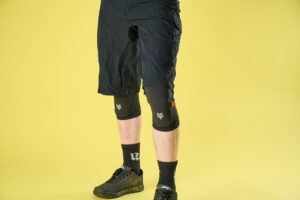If you're looking for greater ground clearance, Hope's new 155mm EVO Crankset has been designed to fulfill those needs
Hope 155mm EVO Crankset review
Hope initially made short EVO cranks for extra clearance on e-bikes, and ended up experimenting with even shorter lengths after seeing some additional benefits. The brand settled on 155mm as a sweet spot, using the same second-generation, self-extracting, 7150 alloy arms and oversized 30mm splined 7075 axles across a variety of fitment widths. Hope has already earned a spot among the best mountain bike cranks on sale, but can it take that to the next level with these shorties?
Being shorter means the cranks are lighter and stiffer, but Hope also champions extra ground clearance, a more centred rider stance, extra stability and faster cadence as additional benefits. The stability is due to more centred feet having less rotational force/leverage to deflect the bike from pointing dead forwards when pinballing through rough stuff.
The extra ground clearance is undeniable, and I found that extra 15mm over a typical 170mm crankarm makes a huge difference. Being able to pedal almost everywhere without ever clipping the floor is a big deal; especially smuggling cranks over rough ground. This could be an advantage in certain racing scenarios, and it increases safety by reducing the potential for clipping rocks and stumps.
The tighter stance, where your leading and trailing feet are closer together, feels a bit more like being stood on skis, and is actually quite noticeable. Although hard to get used to at first, I found it easier to tip side-to-side from the hips when driving and threading the bike along trails. The flip side, however, is less leverage from (especially) the back foot to steer the bike, cutting into turns, or initiating Scandi flicks.
Longer cranks exert more of a calming force on the suspension, by stabilising bike and rider weight through the chain. It was only when running the 155mm cranks that I realised the significance of this effect. With the shorter cranks there’s more of a chainless feel, where the suspension is slightly freer, but there’s less drive to pump hollows and stay supported in deep berms. I added compression to the shock to counter it, but the bike still didn’t feel exactly as I wanted.
The main thing I really didn’t like with Hope’s stubby cranks is the pedalling action. I tend to stomp the downstroke to get up steep hills and accelerate, and for me there’s not enough drive through the power stroke with each crank revolution. I couldn’t accelerate as effectively in short bursts, when exiting turns, to boost back up to speed. There’s also a reduction in leverage when climbing, particularly over small ledges.
It’s not a slight difference either; the amount of extra spin needed to generate the same torque and forward momentum is massive. Maybe it’s age or physiology, but my legs don’t felt happy at 100rpm, and that’s what you’ll need to aim for with these cranks. Even if you drop teeth on the front chainring to balance gear ratios (Hope recommends two), you’ll still often be in the 52-tooth on the cassette twiddling away and feeling slow. You’ll also be in the least efficient chain line zone, and running a smaller chainring may mess up the anti-squat.
Compared to SRAM’s GX Eagle cranks, on the same bike, Hope’s cranks didn’t feel as solid or positive, either under power and when steering with feet. Basically, Hope’s expensive cranks feel a bit soft, and using big flat pedals clearly twists the tips of the machined arms, which feels vaguer both pedalling and controlling the bike.
Looking for more options? Check out our guide to the best mountain bike cranks. And if you need the rest of the system, we’ve tested a whole lot of kit so you can choose the best mountain bike drivetrain for your needs.
Verdict
I get why Hope sees something in 155mm cranks, but even though I’m not tall, this experiment proved, on an analogue bike at least, the concept isn’t for me. My conclusion is my minimum length would be 165mm, which feels like it strikes a better compromise between power delivery, cadence, clearance and stability.
















